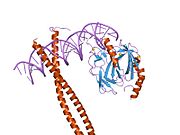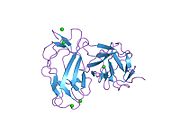RUNX2
Ensembl | |||||||||
|---|---|---|---|---|---|---|---|---|---|
| UniProt | |||||||||
| RefSeq (mRNA) |
| ||||||||
| RefSeq (protein) |
| ||||||||
| Location (UCSC) | Chr 6: 45.33 – 45.66 Mb | Chr 17: 44.81 – 45.13 Mb | |||||||
| PubMed search | [3] | [4] | |||||||
| View/Edit Human | View/Edit Mouse |

Runt-related transcription factor 2 (RUNX2) also known as core-binding factor subunit alpha-1 (CBF-alpha-1) is a protein that in humans is encoded by the RUNX2 gene. RUNX2 is a key transcription factor associated with osteoblast differentiation.
It has also been suggested that Runx2 plays a cell proliferation regulatory role in
Function
Osteoblast differentiation
This protein is a member of the RUNX family of transcription factors and has a
The cellular dynamics of Runx2 protein are also important for proper osteoblast differentiation. Runx2 protein is detected in
Knock-out of the DNA-binding activity results in inhibition of osteoblastic differentiation. Because of this, Runx2 is often referred to as the master regulator of bone.[7]
Cell cycle regulation
In addition to being the master regulator of osteoblast differentiation, Runx2 has also been shown to play several roles in cell cycle regulation. This is due, in part, to the fact that Runx2 interacts with many cellular proliferation genes on a
Oscillating levels of Runx2 within the cell contribute to cell cycle dynamics. In the
In addition, Runx2 has been shown to interact with several kinases that contribute to facilitate cell-cycle dependent dynamics via direct protein phosphorylation. Furthermore, Runx2 controls the gene expression of cyclin D2, D3, and the CDK inhibitor p21(cip1) in hematopoietic cells. It has been shown that on a molecular level, Runx associates with the cdc2 partner cyclin B1 during mitosis.[10] The phosphorylation state of Runx2 also mediates its DNA-binding activity. The Runx2 DNA-binding activity is correlated with cellular proliferation, which suggests Runx2 phosphorylation may also be related to Runx2-mediated cellular proliferation and cell cycle control. To support this, it has been noted that Runx is phosphorylated at Ser451 by cdc2 kinase, which facilitates cell cycle progression through the regulation of G2 and M phases.[10]

Pathology
Cleidocranial dysplasia
Mutations in Runx2 are associated with the disease Cleidocranial dysostosis. One study proposes that this phenotype arises partly due to the Runx2 dosage insufficiencies. Because Runx2 promotes exit from the cell cycle, insufficient amounts of Runx2 are related to increased proliferation of osteoblasts observed in patients with cleidocranial disostosis.[11]
Osteosarcoma
Variants of Runx2 have been associated with the osteosarcoma phenotype.[5] Current research suggests that this is partly due to the role of Runx2 in mitigating the cell cycle.[6] Runx2 plays a role as a tumor suppressor of osteoblasts by halting cell cycle progression at G1.[5] Compared to normal osteoblast cell line MC3T3-E1, the oscillations of Runx2 in osteosarcoma ROS and SaOS cell lines are aberrant when compared to the oscillations of Runx2 levels in normal osteoblasts, suggesting that deregulation of Runx2 levels may contribute to abnormal cell proliferation by an inability to escape the cell cycle. Molecularly, It has been proposed that proteasome inhibition by MG132 can stabilize Runx2 protein levels in late G1 and S in MC3T3 cells, but not in osteosarcoma cells which consequently leads to a cancerous phenotype.[6][5]
Regulation and co-factors
Due to its role as a master transcription factor of osteoblast differentiation, the regulation of Runx2 is intricately connected to other processes within the cell.
Furthermore, in proliferating chondrocytes, Runx2 is inhibited by CyclinD1/CDK4 as part of the cell cycle.[13]
Interactions
RUNX2 has been shown to
and
miR-133 and CyclinD1/CDK4 directly inhibits Runx2.[24][13]
See also
References
- ^ a b c GRCh38: Ensembl release 89: ENSG00000124813 – Ensembl, May 2017
- ^ a b c GRCm38: Ensembl release 89: ENSMUSG00000039153 – Ensembl, May 2017
- ^ "Human PubMed Reference:". National Center for Biotechnology Information, U.S. National Library of Medicine.
- ^ "Mouse PubMed Reference:". National Center for Biotechnology Information, U.S. National Library of Medicine.
- ^ PMID 19739101.
- ^ PMID 22949168.
- ^ PMID 25555110.
- PMID 15781466.
- PMID 14500368.
- ^ PMID 16407259.
- PMID 19028669.
- S2CID 20760228.
- ^ PMID 883617.
- PMID 19389811.
- PMID 18755791.
- ^ PMID 11274169.
- ^ PMID 11641401.
- PMID 15292260.
- PMID 11965546.
- ^ PMID 10962029.
- ^ PMID 10531362.
- PMID 18541707.
- PMID 34667264.
- PMID 18784367.
Further reading
- Otto F, Kanegane H, Mundlos S (March 2002). "Mutations in the RUNX2 gene in patients with cleidocranial dysplasia". Human Mutation. 19 (3): 209–16. S2CID 2578591.
- Komori T (March 2002). "[Cbfa1/Runx2, an essential transcription factor for the regulation of osteoblast differentiation]". Nihon Rinsho. Japanese Journal of Clinical Medicine. 60 (Suppl 3): 91–7. PMID 11979975.
- Stock M, Otto F (June 2005). "Control of RUNX2 isoform expression: the role of promoters and enhancers". Journal of Cellular Biochemistry. 95 (3): 506–17. S2CID 29657025.
- Blyth K, Cameron ER, Neil JC (May 2005). "The RUNX genes: gain or loss of function in cancer". Nature Reviews. Cancer. 5 (5): 376–87. S2CID 335980.
- Schroeder TM, Jensen ED, Westendorf JJ (September 2005). "Runx2: a master organizer of gene transcription in developing and maturing osteoblasts". Birth Defects Research. Part C, Embryo Today. 75 (3): 213–25. PMID 16187316.
- Frenkel B, Hong A, Baniwal SK, Coetzee GA, Ohlsson C, Khalid O, Gabet Y (August 2010). "Regulation of adult bone turnover by sex steroids". Journal of Cellular Physiology. 224 (2): 305–10. PMID 20432458.
External links
- GeneReviews/NCBI/NIH/UW entry on Cleidocranial Dysplasia
- Runx2+protein at the U.S. National Library of Medicine Medical Subject Headings (MeSH)








